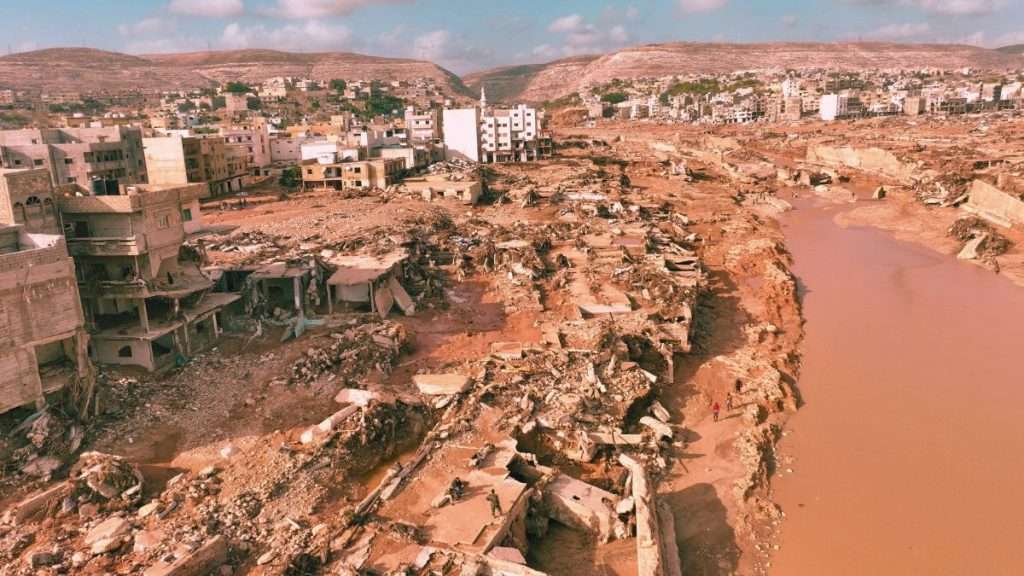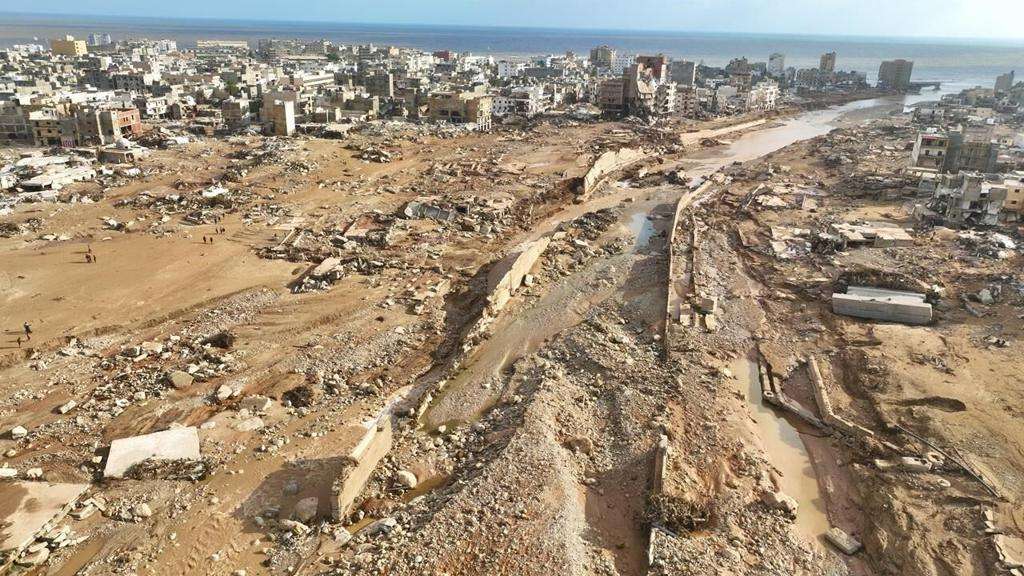Libya Flood: 6,000 dead, 10,000 missing, neighbourhoods gone

Flash flooding caused by a storm wreaked havoc on Libya.
On the 11th September, storm Daniel hit Libya, affecting the Eastern region of the country more severely, Al Jazeera reports.
Thousands have died as a result of the floods in Libya.
The death toll is over 6,000 people, according to Saadeddin Abdul Wakil, health ministry undersecretary of the Unity Government in Tripoli.
Around 10,000 people are missing, as the Flood either swept them away to the sea or they were unable to leave their homes and were buried under rubble.
The United Nations International Organisation for Migration (IOM), said that over 30,000 people have been displaced as a result of the flooding in Derna.
Moreover, entire neighbourhoods have been wiped off the face of the Earth.
Libya is a country which has been in a civil war for over a decade now, ever since NATO backed an uprising against late-president Moammar Gadhafi in 2011.
During the Arab Spring, the country was split into two regions; the Western and the Eastern. Since 2014, it has had two rival governments for each region.
The government of the eastern region is not recognised internationally. The east is run by Prime Minister Ossama Hamad, and backed by military commander Khalifa Hiftar. He is backed by Russia, Egypt, Jordan and the United Arab Emirates.
The government in Tripoli is the one acknowledged internationally, it is led by Prime Minister Abdul Hamid Dbeibah. The administration is backed by Turkey, Qatar and Italy.
Derna: A quarter of a city wiped off
Derna, a city in the east, has been hit the hardest. It was home to roughly 100,000 people. The city had two major dams. Derna lies in a river “wadi” (a dried river bed)
 Both dams collapsed, submerging huge chunks of the region. According to Al Jazeera, the two dams that burst upstream released an estimated 30 million cubic meters of water. This tore through the city rapidly, taking houses, streets, cars and people with it. The flood swept down Wadi Derna from the mountains to the sea.
Both dams collapsed, submerging huge chunks of the region. According to Al Jazeera, the two dams that burst upstream released an estimated 30 million cubic meters of water. This tore through the city rapidly, taking houses, streets, cars and people with it. The flood swept down Wadi Derna from the mountains to the sea.
Speaking to Al Jazeera, Deputy Mayor, Ahmed Madroud, said that the way that the city is built puts most of the population in the water’s direct path. He also said that the infrastructure was not built to withstand the effect of the Flood.
What’s more, is that both of these dams had not been maintained for more than two decades, Madroud said.
Natural disaster or human disaster?
Unlike the devastating earthquake that hit Morocco recently, which shook up so much of the country in seconds. Storm Daniel was in fact known and expected, not with the severity that it had, but the movement of an area of low pressure, sweeping through the Mediterranean, all the way through to North Africa, was something that was reported on and made public knowledge by meteorologists all over the world. Moreover, unlike the earthquake in Morocco, the storm took hours to unfold at its full capacity and remained for hours, without any government officials or organisations attempting to send help to their own people.
READ: 6.8 magnitude earthquake hits central Morocco
Echoing this statement, Anas el Gomati, of the country’s Sadeq Institute, has pointed out, this is not like the earthquake that struck without warning in Morocco last week, killing at least 2,900 people. Officials saw Storm Daniel’s impact in Greece and had days to plan an evacuation. Some people were apparently told to leave, but others were reportedly ordered to stay at home even as water swelled behind the dams, the Guardian wrote.
Storm Daniel for other countries
Storm Daniel has already hit both Greece as well as Turkey just days ago during the first week of September. While the storm flooded many parts of both countries, and also caused damage to the infrastructure. The severity of just how much of a country was wiped off maps, and how many fatalities were a result of the Flood, was a completely different prospect in both of those countries.
For instance, in Greece, the number of confirmed deaths was 15 people, while 4 people were reported missing, according to Reuters.
Meanwhile, in Turkey, the cyclone resulted in a total of 7 deaths across the country.
Compare that however to the 6,000 deaths and the estimated 10,000 people missing.
Both in Greece and in Turkey, while devastating effects did take place, it was nowhere near as fatal for as many people as it was in Libya. But the important question is why?
A country neglected?
At the very basic level, the infrastructure and security maintenance of the dams have since been revealed to have always been an issue in Libya, which the government knew about for many years but refused to do anything to improve the situation.
As a result of the complete destruction of cities like Derna, members of the public as well as experts have come forward to express what they believe might have made this situation much worse than it has to be.
Attention was brought to the nature of the dams and the way they are built, as well as how compatible they were made to be in case of any emergency like the one that unfolded.
News Libya has revealed that the dams were each roughly 70 meters tall. For context, a dam warding off the same volume of water would be considered a “major dam”, which are typically over 150 meters tall.
Derna, Libya, after devastating flooding The United Nations says 30,000 people have been left homeless by the recent flooding in Libya.#Libya l #LibyaFloods l #Derna pic.twitter.com/QrlnkAPNxq
— Globe Eye News (@GlobeEyeNews) September 13, 2023
News Libya also reported that the initial Dam was built in the 1970s by a company from Yugoslavia to control seasonal floods. The company who built the structure described it as an Embankment Dam, that was completed in 1977.
The most important detail of these, however, is the fact that the dam was built with clay and rocks.
This would explain part of the reason that the Flood was so muddy in colour as it swept through the city. It seems that the dam itself disintegrated and became part of the cyclone, along with all other buildings and objects it took with it, making it heavier and more intense as it ravaged the city.
Moreover, Derna Deputy Mayor, Ahmed Madroud, revealed that the structures had not been maintained since 2002.
Dams of clay
Speaking to the National, Malak Altaeb, who is a fellow at the Centre for Climate and Security said that,”Dams in Libya and especially in the east of the country, haven’t received maintenance in years and management bodies haven’t provided adequate financial support and means to support the dams, which has led to adverse effects, instead of protecting from flooding, the dams ended up flooding the city,” she told The National.
Further highlighting how much more destructive muddy water can be, Tilman Roschinski, an expert on hydrology and geology at the Plan4Risk consultancy, told the National, that, if the last flood in the area was in the early 1960s, as Libyan media has reported, fine particles of mud and silt will have built up in the area around the dam since then.
He emphasised that such material, “which would normally have been washed away” by natural flooding over the decades, would have mixed with “the enormous velocity of the floodwater, greatly increasing the pressure on the dam, and increasing its destructive force”.
Such muddy water can have twice the density of normal floodwater, up to 2g per cubic centimetre, he said. That equates to a kind of liquified soil with the density of sinking sand.
sources: Al Jazeera/The National/Reuters/The Guardian
Want to chase the pulse of North Africa?
Subscribe to receive our FREE weekly PDF magazine














